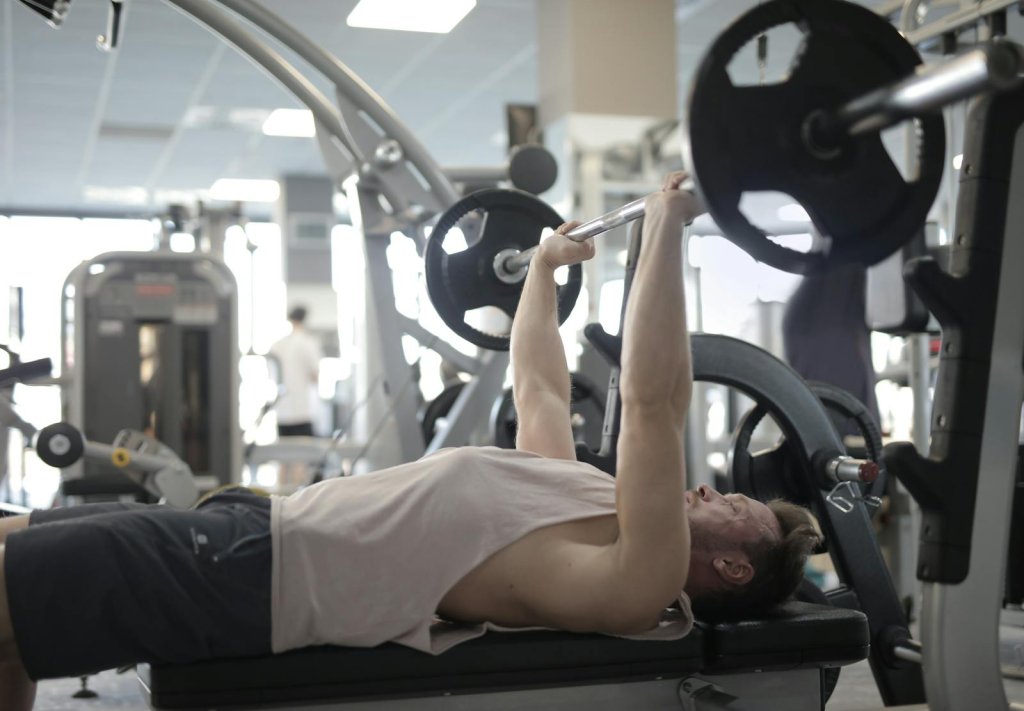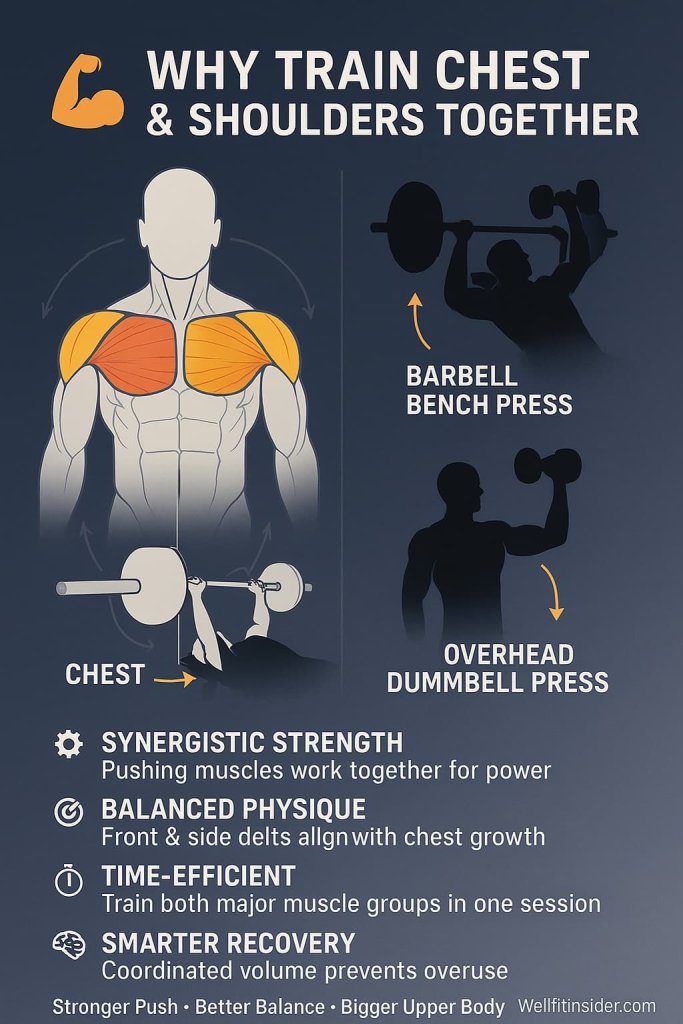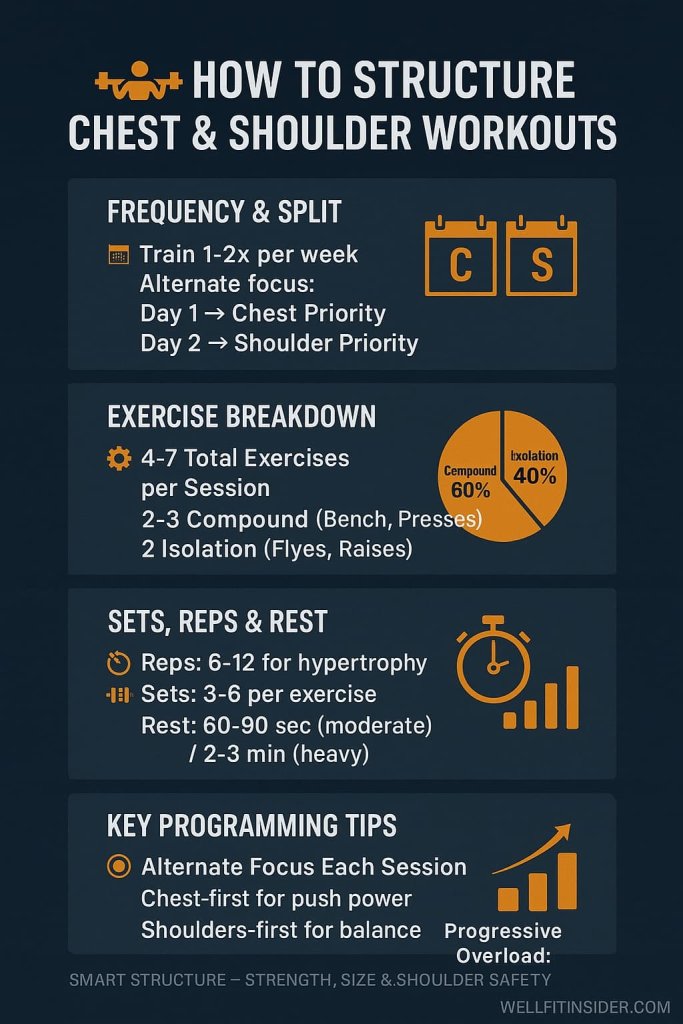Yes — you can build a bigger, stronger upper body by training your chest and shoulders together.
The best chest and shoulder workouts combine compound presses, isolation flyes, and lateral raises to build both size and strength safely and effectively.

Combining these two muscle groups in one workout helps you lift heavier, improve balance, and create a well-defined upper body shape.
Your chest (pectorals) and shoulders (deltoids) are primary pushing muscles. Training them together improves pressing strength, supports joint stability, and maximizes workout efficiency — ideal for anyone wanting more power and size.
Why Train Chest and Shoulders Together
Your chest and shoulders are highly connected — almost every chest press also engages the front deltoids. Training them together allows you to:

- Enhance pressing strength: Both muscles work in synergy on bench and overhead presses.
- Improve symmetry and posture: Balanced front and side development prevents shoulder rounding.
- Save time: Combining these groups lets you hit major upper-body muscles in one efficient session.
- Reduce overtraining risk: Proper structure ensures both muscle groups recover evenly.
Research in the Journal of Strength & Conditioning Research shows that pairing “agonist–antagonist” or related muscle groups in one session (like chest and shoulders) enhances training efficiency and total volume tolerance without reducing performance.
How to Structure Chest and Shoulder Workouts
To build both strength and size:

- Train this combo 1–2 times per week.
- Perform 4–7 total exercises per session (2–3 compound + 2 isolation for each).
- Use 6–12 reps for hypertrophy and 3–6 sets per movement.
- Rest 60–90 seconds between moderate sets, and 2–3 minutes for heavy presses.
Alternate focus each session — for example, “Chest Priority” (chest first) one day, then “Shoulder Priority” next time.
15 Best Chest and Shoulder Workouts
Below are 15 of the most effective exercises to develop a strong, defined upper body. This combination of pressing, fly, and isolation movements targets every area of your chest (upper, mid, and lower) and shoulders (front, side, and rear delts) for balanced, aesthetic growth.
1. Barbell Bench Press (Flat)
Why it works: Often called the king of upper-body lifts, this compound move builds mid-chest mass and overall pressing power. It’s foundational for all strength programs.
Muscles worked: Pectoralis major, front deltoids, triceps.
How to do it:
- Lie flat on a bench with feet planted firmly on the floor.
- Grip the bar slightly wider than shoulder-width.
- Lower the bar slowly to your mid-chest, keeping elbows at about 45°.
- Pause briefly, then press it up until your arms are fully extended.
Trainer Tip: Keep shoulder blades retracted throughout to protect your shoulders and improve pressing stability.
2. Incline Barbell Bench Press
Why it works: Shifts focus to the upper chest and engages the anterior deltoids, helping develop that “full chest” look.
Muscles worked: Upper pectorals, front deltoids, triceps.
How to do it:
- Set a bench to a 30–45° incline.
- Grip the bar slightly wider than shoulder-width.
- Lower the bar to your upper chest, then press it back up in a controlled motion.
Trainer Tip: Avoid angles above 45° — they transfer tension away from the chest and onto the shoulders.
3. Flat Dumbbell Press
Why it works: Allows a greater range of motion and deeper chest stretch than barbell presses, improving muscle activation.
Muscles worked: Chest, front delts, triceps.
How to do it:
- Lie on a flat bench, dumbbells at chest level, palms facing forward.
- Press them together over your chest, then lower under control.
- Keep elbows slightly below shoulder level.
Trainer Tip: Keep wrists neutral and elbows tucked to reduce shoulder strain.
4. Decline Dumbbell or Barbell Press
Why it works: Targets the lower chest, improving overall balance and fullness.
Muscles worked: Lower pectorals, front delts, triceps.
How to do it:
- Set a decline bench to 15–30°.
- Lower the weight toward your lower chest, then press back up.
- Keep movement smooth and elbows tucked.
Trainer Tip: Avoid flaring elbows — control every rep for safety and effectiveness.
5. Seated Cable Fly
Why it works: Keeps tension on your pecs throughout the movement — perfect for sculpting inner chest definition.
Muscles worked: Pectoralis major, front delts.
How to do it:
- Sit upright at a cable station with handles at chest height.
- Pull handles together in front of your chest (like hugging a tree).
- Slowly return to the start position without letting the weight stack touch.
Trainer Tip: Cross hands slightly at the end to enhance the chest squeeze.
6. Pec Deck Machine Fly
Why it works: Provides a safe and isolated chest workout, ideal for beginners or as a finisher after heavy pressing.
Muscles worked: Pectoralis major, anterior deltoids.
How to do it:
- Sit upright with back against the pad.
- Place arms on the machine pads, elbows slightly bent.
- Bring arms together in front of you, squeezing the chest at the end.
Trainer Tip: Adjust seat height so elbows align with mid-chest for proper tension.
7. Incline Cable Fly
Why it works: Isolates upper chest fibers while maintaining constant resistance throughout the movement.
Muscles worked: Upper pectorals, front delts.
How to do it:
- Set cables just below shoulder height.
- Step forward, arms extended slightly down and open.
- Bring handles together upward toward your chin, elbows soft.
- Slowly return to the start.
Trainer Tip: Perform slow, controlled reps for optimal muscle engagement.
8. Standing Cable Chest Press
Why it works: Combines pressing power with balance and core stability — great for functional strength.
Muscles worked: Chest, front delts, triceps, core stabilizers.
How to do it:
- Set cables at chest height and stand in a staggered stance.
- Hold handles close to your chest, palms facing down.
- Press forward until arms are extended, then return slowly.
Trainer Tip: Alternate arms for better muscle control and coordination.
9. Barbell Overhead Press
Why it works: Builds massive shoulder and triceps strength while developing upper chest and core stability.
Muscles worked: Front and lateral deltoids, triceps, upper chest.
How to do it:
- Stand with feet shoulder-width apart.
- Grip barbell at collarbone height, elbows slightly forward.
- Press overhead, keeping core tight and ribs down.
- Lower the bar under control.
Trainer Tip: Don’t overarch your back — brace your core like you’re about to take a punch.
10. Seated Dumbbell Shoulder Press
Why it works: Strengthens both shoulders evenly and improves control through independent movement.
Muscles worked: Front and side deltoids, triceps.
How to do it:
- Sit upright with dumbbells at shoulder height.
- Press them overhead until arms are fully extended.
- Lower slowly until elbows are just below 90°.
Trainer Tip: Avoid locking elbows to keep tension on delts throughout.
11. Arnold Press
Why it works: Developed by Arnold Schwarzenegger — this press variation hits all three heads of the deltoids through rotation.
Muscles worked: Front, side, and rear deltoids; triceps.
How to do it:
- Hold dumbbells in front of your chest, palms facing you.
- Rotate wrists outward as you press overhead.
- Reverse the motion on the way down.
Trainer Tip: Keep movement fluid — jerky rotations can strain shoulder joints.
12. Dumbbell Lateral Raise
Why it works: Adds width to your shoulders by isolating the side delts.
Muscles worked: Lateral deltoids, upper traps.
How to do it:
- Stand tall with dumbbells at your sides.
- Raise arms out to shoulder height, elbows slightly bent.
- Lower under control.
Trainer Tip: Lead with elbows, not wrists. Keep torso still — avoid swinging.
13. Rear Delt Fly (Dumbbell or Reverse Pec Deck)
Why it works: Strengthens the rear delts for better posture and shoulder balance — essential for joint health.
Muscles worked: Rear deltoids, rhomboids, traps.
How to do it:
- Bend forward slightly (or use a reverse pec deck).
- With arms slightly bent, lift weights out to the sides.
- Squeeze shoulder blades together at the top.
Trainer Tip: Keep neck neutral and move slowly — focus on feeling the rear delts contract.
14. Dumbbell Front Raise
Why it works: Builds anterior deltoid strength for stronger pressing movements and better upper chest support.
Muscles worked: Front deltoids, upper chest.
How to do it:
- Hold dumbbells or a weight plate in front of your thighs.
- Raise to shoulder height, pause, then lower slowly.
Trainer Tip: Use a light weight and strict form — momentum kills the benefit.
15. Chest-Lean Dips (Weighted Optional)
Why it works: Combines chest and shoulder activation, especially the lower pecs, while improving triceps power.
Muscles worked: Lower chest, anterior deltoids, triceps.
How to do it:
- Grip parallel bars and lean forward slightly.
- Lower your body until elbows reach 90°, then press up.
- Keep chest slightly forward to emphasize pecs.
Trainer Tip: Use bodyweight first; add weight only when you can do 10–12 clean reps.
Final Tips for Chest and Shoulder Training
- Warm up: Always begin with 5–10 minutes of light cardio and shoulder mobility drills.
- Progressive overload: Gradually increase weight or reps each week.
- Mind-muscle connection: Focus on squeezing your chest and shoulders during each rep.
- Frequency: Train chest and shoulders 1–2 times per week with at least 48 hours between sessions.
- Recovery: Sleep, hydration, and protein intake are essential for muscle growth.
Sample Chest and Shoulder Workouts
A. Chest-Focused Day
- Barbell Bench Press – 4×6
- Incline Dumbbell Press – 3×8
- Seated Cable Fly – 3×12
- Dumbbell Shoulder Press – 3×10
- Lateral Raise – 3×15
B. Shoulder-Focused Day
- Barbell Overhead Press – 4×6
- Arnold Press – 3×8
- Lateral Raise – 3×12
- Pec Deck Fly – 3×12
- Dips – 3×10
Rest 48–72 hours between sessions for full recovery.
Common Mistakes When Training Chest and Shoulders
Avoid these errors to stay injury-free and maximize gains:
- Overlapping push days – causes fatigue and poor recovery.
- Neglecting rear delts – leads to posture issues.
- Using too much weight – reduces control and tension.
- Skipping warm-ups – increases injury risk.
- Flaring elbows on presses – stresses shoulder joints.
- Rushing reps – weakens muscle activation.
- Training through pain – delays recovery.
Safety & Programming Tips
- Warm up with 5–10 minutes of light cardio and shoulder mobility drills.
- Stretch chest and shoulder muscles post-workout.
- Avoid overuse: pressing too often can strain front delts.
- Include rear-delt and rotator cuff work weekly to maintain shoulder health.
Frequently Asked Questions (FAQ)
1. Can I train chest and shoulders on the same day?
Yes. It’s efficient and safe when programmed properly. Start with compound lifts and balance push volume with recovery.
2. Should I train shoulders or chest first?
If your chest is a priority, train it first while you’re fresh. Alternate each session for balanced growth.
3. How many times a week should I train them together?
1–2 sessions weekly is ideal with 48–72 hours rest between.
4. Are shoulder presses enough for chest growth?
No. Shoulder presses mainly target delts. Include chest-specific presses and flyes for full development.
5. Can beginners do this workout?
Yes. Start with lighter weights and focus on form before increasing load.
6. What’s the best rep range for growth?
6–12 reps per set for hypertrophy, 3–6 for strength, and 12–15 for isolation moves.
7. What if I have shoulder pain?
Avoid deep dips and heavy overhead presses. Focus on form and consult a physiotherapist if pain persists.
Conclusion
Building a strong, defined upper body doesn’t require endless exercises — it’s about combining the right ones. Training chest and shoulders together boosts pressing strength, symmetry, and size when structured smartly.
Stay consistent, focus on form, and alternate focus days for long-term progress.
References
- American College of Sports Medicine (ACSM) Position Stand – Progression Models in Resistance Training for Healthy Adults
Foundational guideline for training frequency, load progression, and volume in strength/hypertrophy programs.
👉 Read on PubMed
- Rodríguez-Ridao D. et al., 2020 — Effect of Five Bench Inclinations on EMG of the Pectoralis Major
EMG study showing how different bench angles alter upper, middle, and lower chest activation — supports flat, incline, and decline variations.
👉 Read on PMC
- Campos Y.A.C. et al., 2020 — Different Shoulder Exercises Affect Deltoid Activation
Compared bench presses, flyes, and raises — confirms lateral, front, and rear delt recruitment patterns used in your shoulder exercises.
👉 Read on PMC
- Schoenfeld B.J. & Grgic J., 2021 — Loading Recommendations for Strength and Hypertrophy
Defines effective rep ranges (6–12 reps at 60–80% 1RM) and set volumes for hypertrophy — supports your workout structure and programming tips.
👉 Read on PMC
- Behenck C. et al., 2022 — Rest Intervals in Agonist–Antagonist Paired Sets: Effects on Training Performance
Shows efficiency and volume benefits of pairing push–pull or related muscle groups (like chest and shoulders) within one session.
👉 Read on PubMed
